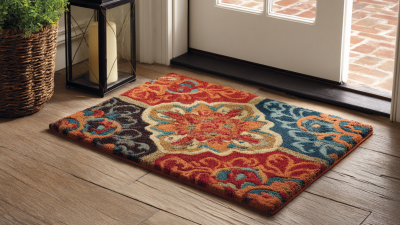Revolutionizing Workplace Safety: The Essential Role of Industrial Mats in Hazard Prevention
In today's rapidly evolving industrial landscape, workplace safety remains a paramount concern, with recent statistics revealing that over 4 million workplace injuries occur annually in the United States alone, leading to significant financial and emotional costs for both employees and employers. One critical yet often overlooked element in enhancing safety protocols is the use of industrial mats. These mats serve as essential protective barriers, reducing slip and fall accidents by as much as 50%, according to a report by the National Safety Council. Furthermore, industrial mats can also bolster efforts in hazard prevention by offering anti-fatigue benefits, improving worker comfort and productivity. By integrating high-quality industrial mats into workplace environments, organizations not only comply with safety regulations but also cultivate a culture of safety that prioritizes the well-being of their workforce.

Elevating Safety Standards: The Impact of Industrial Mats in High-Risk Areas
 Industrial mats have emerged as a crucial element in enhancing safety standards in high-risk areas. In environments such as factories, warehouses, and construction sites, the prevalence of hazards like slips, trips, and falls is significantly heightened. By implementing industrial mats, businesses can create a safer working environment that not only protects employees but also minimizes costly accidents. These mats are designed with features such as anti-slip surfaces and shock absorption capabilities, effectively reducing the risk of injury and contributing to overall workplace safety.
Industrial mats have emerged as a crucial element in enhancing safety standards in high-risk areas. In environments such as factories, warehouses, and construction sites, the prevalence of hazards like slips, trips, and falls is significantly heightened. By implementing industrial mats, businesses can create a safer working environment that not only protects employees but also minimizes costly accidents. These mats are designed with features such as anti-slip surfaces and shock absorption capabilities, effectively reducing the risk of injury and contributing to overall workplace safety.
Furthermore, the impact of industrial mats goes beyond mere accident prevention. They also play a vital role in boosting productivity by ensuring employees feel secure in their workspaces. When workers are confident that their surroundings are safe, they can focus on their tasks without the distraction of potential hazards. Additionally, these mats can delineate dangerous areas, providing a visual cue for employees to remain vigilant. As organizations increasingly prioritize safety, the incorporation of industrial mats will continue to be an essential strategy in fostering a culture of prevention and care within high-risk environments.
Choosing the Right Industrial Mats: Materials and Features for Optimal Protection
When it comes to workplace safety, the choice of industrial mats plays a critical role in hazard prevention. Selecting the right materials is essential for ensuring maximum protection in high-risk environments. According to the Occupational Safety and Health Administration (OSHA), slips, trips, and falls account for roughly 15% of all accidental deaths in the workplace, emphasizing the need for effective flooring solutions. Industrial mats made from anti-slip rubber or vinyl are designed to provide superior traction, significantly reducing the likelihood of accidents.
In addition to material selection, the features of industrial mats can enhance their protective capabilities. Mats that offer features like drainage holes can help manage liquids, preventing pooling that leads to slips. Furthermore, cushioned mats not only provide comfort for employees who stand for extended periods but also reduce the impact of falls, thereby mitigating injury risks. A report by the National Safety Council highlights that environments equipped with proper matting systems see up to a 70% reduction in slip and fall incidents, underscoring the importance of investing in high-quality industrial mats tailored to specific workplace needs.
Maintenance Matters: How to Care for Industrial Mats to Ensure Longevity
Industrial mats play a pivotal role in enhancing workplace safety, but their effectiveness largely depends on proper maintenance. Regular cleaning and inspection can significantly extend the lifespan of these mats, which can average around five years if cared for correctly. According to a report by the National Safety Council, slip and fall accidents account for over 25,000 workplace injuries each year, emphasizing the importance of maintaining mats in optimal condition to prevent such incidents.
To ensure the longevity of industrial mats, implementing a structured maintenance routine is essential. This includes regular vacuuming or sweeping to remove dirt and debris that can compromise the mat's grip. Additionally, washing mats with a mild detergent solution every three to six months can help retain their anti-slip properties and appearance. The Occupational Safety and Health Administration (OSHA) highlights that well-maintained mats can reduce the risk of workplace injuries by up to 40%, underscoring the critical role that proper care plays not only in preserving the mats but also in fostering a safer work environment.
Revolutionizing Workplace Safety: The Role of Industrial Mats in Hazard Prevention
Enhancing Workplace Training: Incorporating Mats into Safety Protocols
Incorporating industrial mats into workplace safety protocols can significantly enhance training effectiveness and hazard prevention. Mats designed for specific environments provide crucial feedback to employees about their surroundings, promoting awareness and attention. For instance, anti-slip mats can serve as visual and physical reminders to employees about potential slip hazards, encouraging a culture of safety from the ground up.
Tips: When integrating mats into training sessions, consider demonstrating their use in various scenarios. Highlight how mats can absorb impact in high-traffic areas, reducing the likelihood of injuries. Encourage employees to suggest locations for mats that could improve safety, fostering engagement and a proactive approach to risk management.
Moreover, regular safety audits should include evaluations of mat condition and placement. Ensure that all staff are trained on the importance of maintaining these mats, as worn or damaged mats can compromise their effectiveness. Incorporate quizzes or discussions in safety meetings to reinforce the crucial role of mats in preventing accidents, making them a key element of your overall safety culture.
Real-World Success Stories: Companies Benefiting from Industrial Mats in Safety Measures
Industrial mats are increasingly becoming an essential component in workplace safety initiatives, with numerous companies reporting significant improvements in hazard prevention by integrating these protective solutions into their environments. For instance, an automotive manufacturer implemented anti-fatigue mats in their production floor, leading to a notable decrease in employee fatigue-related incidents. This practical approach not only enhanced worker comfort but also reduced the likelihood of accidents, showcasing the direct benefits of investing in quality industrial mats.

Tips for Choosing the Right Industrial Mats:
1. Consider Material: Select mats that are designed for the specific hazards of your work environment, such as chemical spills, heat resistance, or anti-slip surfaces.
2. Assess Size and Coverage: Ensure the mats cover high-traffic areas adequately to minimize potential risks and promote safety. Custom sizes can be beneficial for unique floor plans.
3. Regular Maintenance: Implement a maintenance schedule to inspect and clean mats frequently, ensuring they continue to perform effectively while contributing to a safe workplace.
These real-world success stories not only highlight the importance of industrial mats in safety measures but also encourage companies to reassess their safety strategies for enhanced worker welfare and productivity.
Related Posts
-

How to Choose the Best Commercial Floor Mats for Your Business Needs
-

2025 Market Insights: The Future Innovations in Best Commercial Mats
-

Solutions for Choosing the Best Commercial Mats for Your Business Needs
-

How to Choose the Best Outside Door Mats for Every Home Style
-

7 Essential Tips for Choosing the Best Gym Floor Mats for Your Fitness Space
-

What is the Importance of Outdoor Rubber Mats in Enhancing Safety and Comfort
